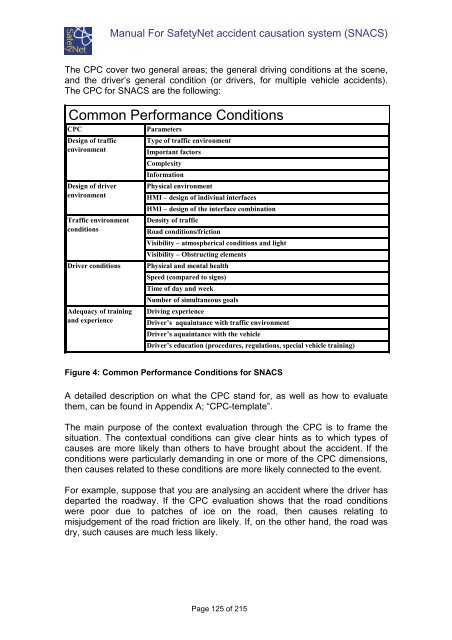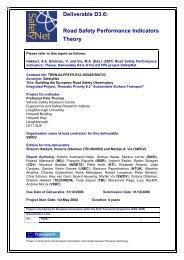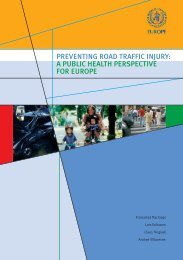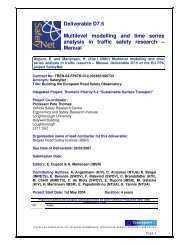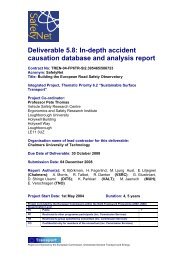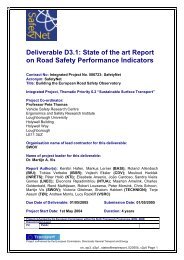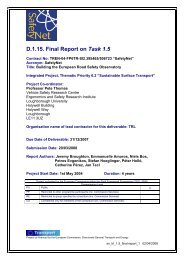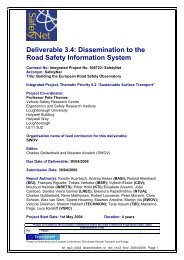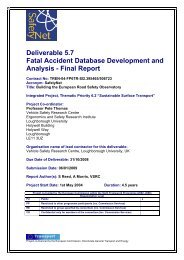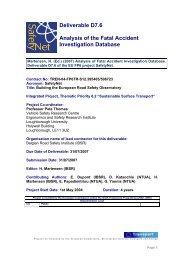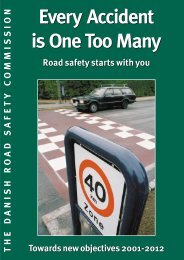Glossary of Data Variables for Fatal and accident causation ... - ERSO
Glossary of Data Variables for Fatal and accident causation ... - ERSO
Glossary of Data Variables for Fatal and accident causation ... - ERSO
You also want an ePaper? Increase the reach of your titles
YUMPU automatically turns print PDFs into web optimized ePapers that Google loves.
Manual For SafetyNet <strong>accident</strong> <strong>causation</strong> system (SNACS)<br />
The CPC cover two general areas; the general driving conditions at the scene,<br />
<strong>and</strong> the driver’s general condition (or drivers, <strong>for</strong> multiple vehicle <strong>accident</strong>s).<br />
The CPC <strong>for</strong> SNACS are the following:<br />
Common Per<strong>for</strong>mance Conditions<br />
CPC<br />
Parameters<br />
Design <strong>of</strong> traffic<br />
environment<br />
Design <strong>of</strong> driver<br />
environment<br />
Traffic environment<br />
conditions<br />
Driver conditions<br />
Adequacy <strong>of</strong> training<br />
<strong>and</strong> experience<br />
Type <strong>of</strong> traffic environment<br />
Important factors<br />
Complexity<br />
In<strong>for</strong>mation<br />
Physical environment<br />
HMI – design <strong>of</strong> indiviual interfaces<br />
HMI – design <strong>of</strong> the interface combination<br />
Density <strong>of</strong> traffic<br />
Road conditions/friction<br />
Visibility – atmospherical conditions <strong>and</strong> light<br />
Visibility – Obstructing elements<br />
Physical <strong>and</strong> mental health<br />
Speed (compared to signs)<br />
Time <strong>of</strong> day <strong>and</strong> week<br />
Number <strong>of</strong> simultaneous goals<br />
Driving experience<br />
Driver’s aquaintance with traffic environment<br />
Driver’s aquaintance with the vehicle<br />
Driver’s education (procedures, regulations, special vehicle training)<br />
Figure 4: Common Per<strong>for</strong>mance Conditions <strong>for</strong> SNACS<br />
A detailed description on what the CPC st<strong>and</strong> <strong>for</strong>, as well as how to evaluate<br />
them, can be found in Appendix A; “CPC-template”.<br />
The main purpose <strong>of</strong> the context evaluation through the CPC is to frame the<br />
situation. The contextual conditions can give clear hints as to which types <strong>of</strong><br />
causes are more likely than others to have brought about the <strong>accident</strong>. If the<br />
conditions were particularly dem<strong>and</strong>ing in one or more <strong>of</strong> the CPC dimensions,<br />
then causes related to these conditions are more likely connected to the event.<br />
For example, suppose that you are analysing an <strong>accident</strong> where the driver has<br />
departed the roadway. If the CPC evaluation shows that the road conditions<br />
were poor due to patches <strong>of</strong> ice on the road, then causes relating to<br />
misjudgement <strong>of</strong> the road friction are likely. If, on the other h<strong>and</strong>, the road was<br />
dry, such causes are much less likely.<br />
Page 125 <strong>of</strong> 215


